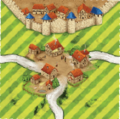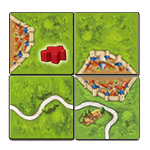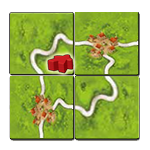The Farmers
General info and comments
Originally released by Hans im Glück in 2014.
Farmers are considered a part of the base game for most Carcassonne players. They are also used in every official tournament as they are not considered an expansion. In the new edition of Carcassonne farmers were separated as a supplement to ease approach to the game for new players. WikiCarpedia follows this streamlined approach. For the sake of other expansions and the rest of the WikiCarpedia, farmers are considered a part of the base game.
What would life be without agriculture? We try to answer part of this question by introducing the hard-working farmers who spend long hours in the fields of Carcassonne. As we did for the roads, cities, and monasteries, the farmers will be presented using the actions of a game turn.
| Changes to the 20th Anniversary Edition and Carcassonne C3
The rules for the 20th Anniversary Edition stay the same but the roles of some meeples have been updated:
Publishers have followed the new roles provided in the rules by HiG, although some of these changes are not noticeable in other languages. Note: We stick to the classic role convension for the sake of consistency with all the exisiting rules for the time being. HiG may decide to update the rules in the future to follow this new naming convention for new releases and reprints. |
Contents
- None. Only contents of base game are used.
Rules
Gameplay
1. Placing a tile
You draw the tile shown, and must place it in such a way that the edges of the tile match the edges of the tiles already in play. Fields always refer to the green spaces found in the landscape of Carcassonne. [1]
2. Placing a meeple as a farmer
A farmer is a meeple that you place “laying down” in a field segment. Unlike highwaymen, knights, and monks that are all placed standing up, farmers are laid down on a tile because they are only scored at the end of the game. Consequently, they are not returned to your supply until the final scoring takes place. [2] Laying farmers down ensures that you remember to leave them on the board. As always, you can only place your farmer if there are no other farmers in the field. The fields of Carcassonne are divided by roads, cities, or anything else that clearly split them visually such as a river. Pictured below are three separate fields.
![]() Question: On monastery tiles, are we allowed to deploy a follower on the surrounding field segment?
Question: On monastery tiles, are we allowed to deploy a follower on the surrounding field segment?
![]() Question: Fields may be closed off when totally surrounded by roads, cities, etc. Does this mean they are completed?
Question: Fields may be closed off when totally surrounded by roads, cities, etc. Does this mean they are completed?
Answer: Fields are never considered completed. Because of that you will never get your farmers back until the final scoring. (1/2021)
3. Scoring fields
As mentioned previously, farmers are not scored during the game and, consequently, they do not return to your supply. So place your farmers wisely. Now, let’s assume the game is over and that we are conducting the final scoring. Unlike other features, it is not the field tiles that are counted, but the number of completed cities that border a field.
Final Scoring
Each completed city that touches a field adds 3 points to the value of that field. All fields touched by a city will see their value increased by 3 points.

Both the yellow and black players have farmers in the same field, but Yellow has control, so the yellow player will be the only one scoring the field's 12 points for completed cities 1 - 4.
The black player in the small field scores 3 points per completed city ( A and B ), for a total of 6 points.
![]() Question: It is unclear whether incomplete fields earn points during the final scoring.
Question: It is unclear whether incomplete fields earn points during the final scoring.
![]() Question: At the end of the game, do we score fields which are completely closed off by roads, but which don't have any adjacent cities? If so, how?
Question: At the end of the game, do we score fields which are completely closed off by roads, but which don't have any adjacent cities? If so, how?
Summary
A brief summary the most important details about farmers:
- Farmers are placed “laying down” on the board.
- Farmers are only scored during the final scoring, not during the game.
- Each completed city adjacent to a field you occupy gives you 3 points.
- Each completed city can be worth points for any number of different fields.
- Similar to roads and cities, if there is more than one farmer in the same field, only the player with the most farmers in that field scores its points. In the case of a tie, each tied player scores full points.
Footnotes
For Icons explanation and licensing please visit Icons page.
- ↑
 In determining field size, fields can be limited by all kinds of barriers, for example, roads, cities, or rivers which cannot be circumvented, or the edge of the playing field. It can certainly happen that a field covers almost the entire playing field, and there will likely be fields that remain open for the entire game.
In determining field size, fields can be limited by all kinds of barriers, for example, roads, cities, or rivers which cannot be circumvented, or the edge of the playing field. It can certainly happen that a field covers almost the entire playing field, and there will likely be fields that remain open for the entire game.
- ↑
 In reality, some special mechanics in some expansions (the Festival, the Dragon, etc.) do allow return of farmers to their owners. (12/2014)
In reality, some special mechanics in some expansions (the Festival, the Dragon, etc.) do allow return of farmers to their owners. (12/2014)






